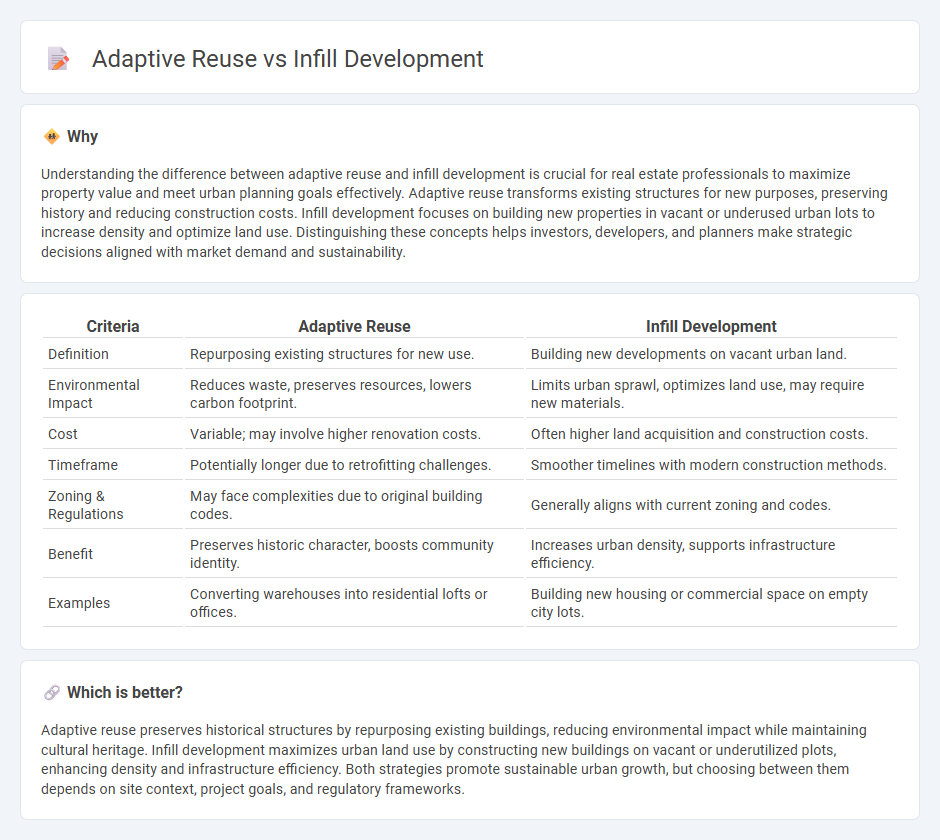
Adaptive reuse involves repurposing existing structures to meet new market demands, optimizing resource efficiency and preserving architectural heritage. Infill development focuses on constructing new buildings on vacant or underutilized urban land, promoting sustainable growth and reducing urban sprawl. Explore the benefits and challenges of both strategies to make informed real estate decisions.
Why it is important
Understanding the difference between adaptive reuse and infill development is crucial for real estate professionals to maximize property value and meet urban planning goals effectively. Adaptive reuse transforms existing structures for new purposes, preserving history and reducing construction costs. Infill development focuses on building new properties in vacant or underused urban lots to increase density and optimize land use. Distinguishing these concepts helps investors, developers, and planners make strategic decisions aligned with market demand and sustainability.
Comparison Table
| Criteria | Adaptive Reuse | Infill Development |
|---|---|---|
| Definition | Repurposing existing structures for new use. | Building new developments on vacant urban land. |
| Environmental Impact | Reduces waste, preserves resources, lowers carbon footprint. | Limits urban sprawl, optimizes land use, may require new materials. |
| Cost | Variable; may involve higher renovation costs. | Often higher land acquisition and construction costs. |
| Timeframe | Potentially longer due to retrofitting challenges. | Smoother timelines with modern construction methods. |
| Zoning & Regulations | May face complexities due to original building codes. | Generally aligns with current zoning and codes. |
| Benefit | Preserves historic character, boosts community identity. | Increases urban density, supports infrastructure efficiency. |
| Examples | Converting warehouses into residential lofts or offices. | Building new housing or commercial space on empty city lots. |
Which is better?
Adaptive reuse preserves historical structures by repurposing existing buildings, reducing environmental impact while maintaining cultural heritage. Infill development maximizes urban land use by constructing new buildings on vacant or underutilized plots, enhancing density and infrastructure efficiency. Both strategies promote sustainable urban growth, but choosing between them depends on site context, project goals, and regulatory frameworks.
Connection
Adaptive reuse and infill development are connected through their shared goal of maximizing land efficiency and preserving existing structures within urban environments. Adaptive reuse transforms obsolete buildings into functional spaces, while infill development focuses on utilizing vacant or underused parcels within established neighborhoods to reduce urban sprawl. Together, they promote sustainable real estate practices by revitalizing communities and optimizing infrastructure investment.
Key Terms
Zoning
Infill development optimizes underutilized urban lots to enhance density and infrastructure without expanding urban sprawl, adhering closely to zoning regulations that often promote higher residential or mixed-use capacity. Adaptive reuse transforms existing structures by repurposing them for new uses, frequently requiring zoning variances or special permits to accommodate changes in building function or occupancy. Explore the nuances of zoning challenges and opportunities in both approaches to maximize urban sustainability and compliance.
Site utilization
Infill development maximizes underutilized urban land by constructing new buildings within existing neighborhoods, promoting higher density and efficient land use. Adaptive reuse transforms existing structures for new purposes, optimizing resource use while preserving historical or cultural significance. Explore how these strategies enhance site utilization and urban sustainability in detail.
Historic preservation
Infill development enhances urban density by constructing new buildings within vacant or underutilized lots, often integrating modern design while respecting the surrounding historic context. Adaptive reuse preserves historic structures by converting them for new purposes, maintaining architectural integrity and cultural heritage, which supports sustainability and community identity. Explore more about balancing infill development and adaptive reuse to protect historic preservation effectively.
Source and External Links
What is Infill Development? | Definition, Key Components & Benefits - Infill development is the process of developing vacant or underutilized parcels within existing urban areas to increase density, utilize infrastructure efficiently, revitalize neighborhoods, and reduce urban sprawl.
What Is Infill Development? | Planopedia - Infill development refers to constructing buildings or facilities on previously unused or underutilized land within developed urban areas, typically to encourage sustainable growth by making use of existing infrastructure.
Infill Development - Office of Land Use and Climate Innovation - Infill development involves building on unused lands within established patterns to reduce greenhouse emissions, prevent urban sprawl, preserve natural lands, and foster vibrant, socially connected communities.
 dowidth.com
dowidth.com